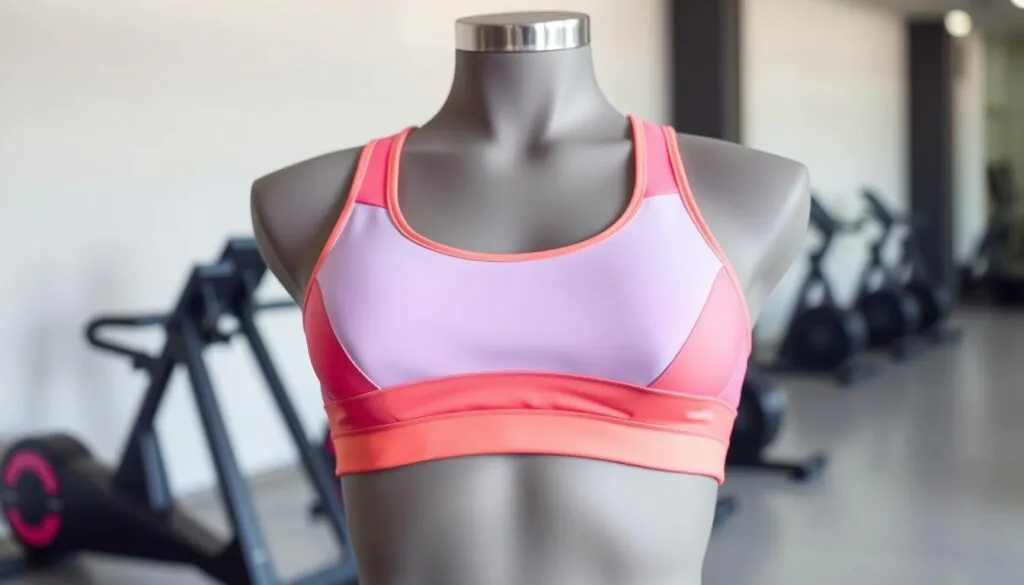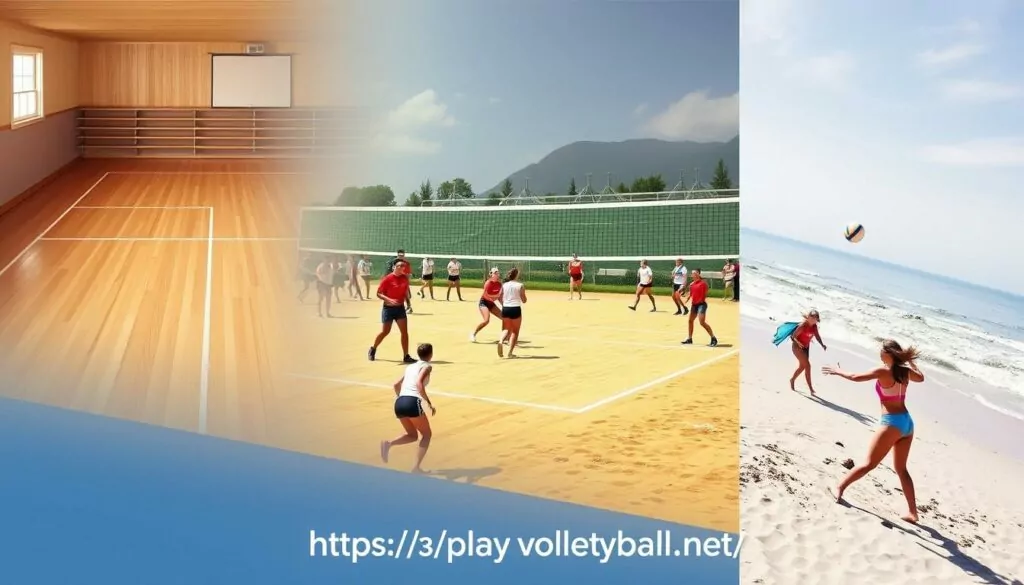Did you know volleyball teams have 10 to 14 players? This lets them make changes during the game. Each player has a special role on the court, from the Setter to the Middle Blocker. Knowing these roles is key for good teamwork and strategy.
The Setter is often the most active player, touching the ball a lot. They usually play in spots 1, 9, and 2. The Libero, on the other hand, is in spots 5 and 7. Outside hitters are in spots 4 and 6, while opposite hitters are in spots 2 and 1. Middle blockers play in spots 3 and 7, depending on the game’s flow.
Key Takeaways
- Volleyball teams typically have 10-14 players to allow for substitutions.
- There are six designated positions on the court, each with specific responsibilities.
- Teams may also have defensive and serving specialists, though these roles are less common.
- The setter is the player who touches the ball the most, while the libero covers the back row.
- Hitters and blockers have assigned positions based on the rotation and serving duties.
Overview of Volleyball Positions
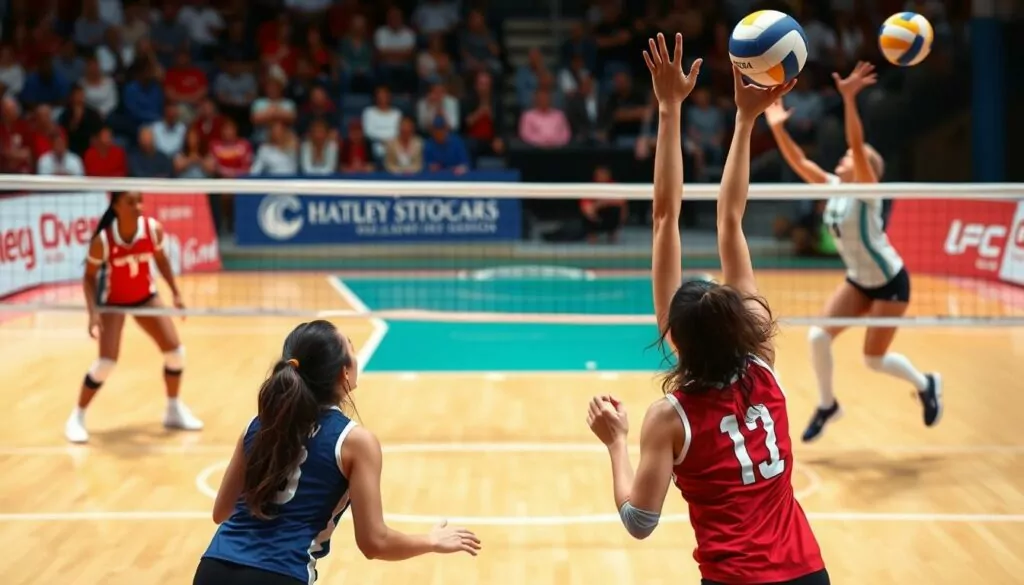
Volleyball is a dynamic sport that requires players to excel in various roles and responsibilities on the court. Understanding the distinct volleyball positions is key for players and coaches to develop effective game strategies. The volleyball court is divided into six main areas, with three players in the front row and three in the back row.
Importance of Understanding Positions
Each volleyball position has specific duties and skill sets that contribute to the team’s success. Knowing the roles and responsibilities of each position helps players improve their skills and work together better. Coaches can use this knowledge to build well-rounded teams and assign players to the right positions.
Different Levels of Play
The nuances of volleyball positions vary slightly depending on the level of play. In recreational settings, players often rotate through different positions, gaining versatility. At more competitive levels, players tend to specialize in specific roles, focusing on their strengths.
How Positions Affect Game Strategy
The arrangement of players on the court impacts the team’s offensive and defensive strategies. Understanding the strengths and weaknesses of each position helps coaches develop tailored game plans. This knowledge is essential for making informed decisions and adapting to changing game dynamics.
In summary, mastering the volleyball positions is a fundamental aspect of the game. By comprehending the unique responsibilities and skill sets of each role, players and coaches can build cohesive, high-performing teams. They can also execute effective game strategies.
The Outside Hitter Role
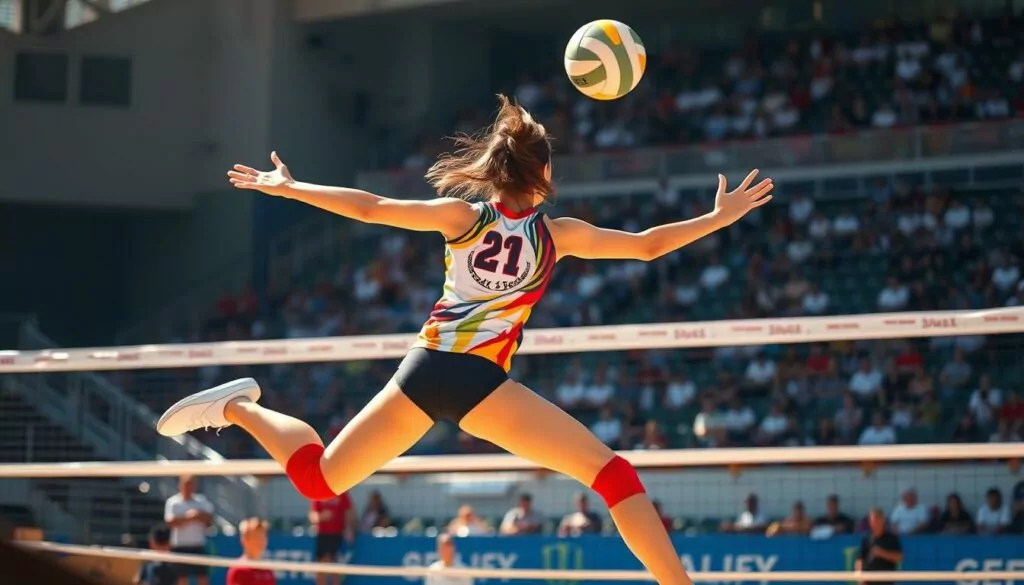
The outside hitter, also known as the left hitter, is key on a volleyball team. They play on the left side of the net. They are the team’s top attackers, known for their powerful spikes.
Outside hitters need to be good at both attacking and defending. They usually stay on the court most of the game.
Key Responsibilities
Outside hitters do many things to help their team win. They can spike from the front and back of the court. This shows they can handle different situations.
They also pass, serve, and defend well. This makes them important players in every match.
Skills Needed
- Exceptional jumping ability for powerful spikes
- Precision in spiking, including cross-court shots, angle shots, and back-row attacks
- Proficient passing and serving skills to set up offensive opportunities
- Solid defensive skills, such as digging and blocking, to disrupt opponent’s attacks
- Strong communication and court awareness to coordinate with teammates
Famous Outside Hitters
The volleyball world has seen many great outside hitters. Some famous names include:
Karch Kiraly, Kerri Walsh Jennings, Wilfredo León, and Destinee Hooker. These players have shown amazing skills, leadership, and dedication. They inspire the next generation of outside hitters and volleyball hitter positions.
The Opposite Hitter Role
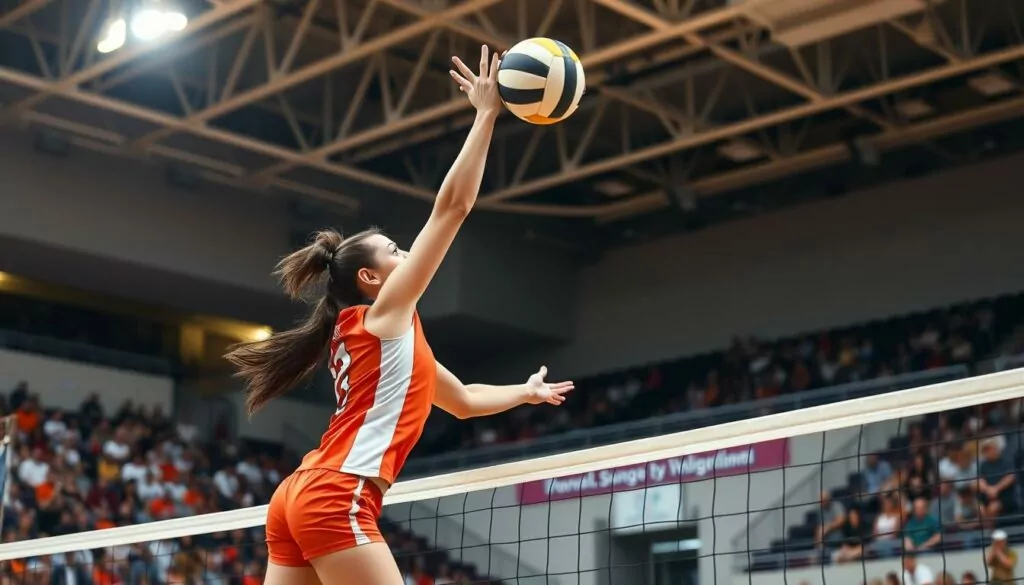
In volleyball, the Opposite Hitter, or right-side hitter, is key. They stand at the net on the right side. Their job is to block shots and attack from the back row. Most are left-handed, fitting their natural skills to the court.
Responsibilities of an Opposite Hitter
Opposite Hitters have big roles. They block shots and control the ball by receiving serves and passing well. They also adjust their hitting based on the opponent’s block.
Unique Skill Sets
Blocking is tough for Opposite Hitters, facing many blockers and varied defenses. They need strong blocking, hitting, serving, and setting skills. These, along with mental strength, make them key to their team.
Notable Players in This Position
Many Opposite Hitters have made a mark in volleyball. Dmitriy Volkov, Ivan Zaytsev, and Saeid Marouf are examples. They’ve led their teams to wins with their skills and leadership.
| Player | Nationality | Achievements |
|---|---|---|
| Dmitriy Volkov | Russia | 2-time Olympic gold medalist, 3-time World Champion |
| Ivan Zaytsev | Italy | 2016 Olympic silver medalist, 2015 European Champion |
| Saeid Marouf | Iran | 2016 Rio Olympics bronze medalist, 2 Asian Games gold medals |
“The Opposite Hitter is the backbone of any volleyball team, providing stability and leadership at the net.” – Legendary Coach, John Kessel
The Setter Role
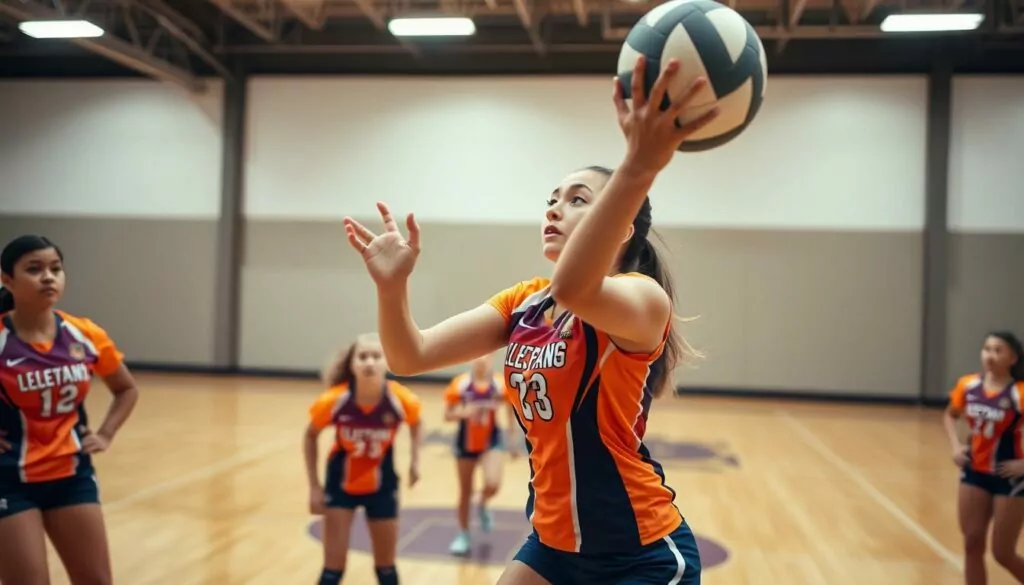
In volleyball, the setter is like a quarterback in football or a point guard in basketball. They lead the team’s attack. The setter touches the ball almost every play, deciding where to send it next. This role is key to keeping the team’s offense moving and creating chances for the hitters.
Role in Game Play
Setters make quick decisions during the game. They choose the right set for their teammates based on the court situation. They know how to spot defensive weaknesses and use them to their advantage. Their precise sets keep the team’s attack flowing smoothly.
Essential Skills for Setters
- Impeccable ball control and technical proficiency to deliver accurate sets
- High level of physical fitness to cover large areas of the court and transition quickly
- Tactical awareness and decision-making skills to manage the team’s offense
- Strong communication skills to coordinate with teammates and provide feedback
- Composure under pressure to maintain a calm and confident attitude
Influential Setters in History
Many setters have made a big impact on volleyball. Fabiana Claudino of Brazil, Lloy Ball of the United States, and Nikola Grbić of Serbia are among them. They have shown great leadership, strategy, and skill, leading their teams to victory.
| Setter | Country | Accolades |
|---|---|---|
| Fabiana Claudino | Brazil | 4-time Olympic medalist, 3-time World Champion |
| Lloy Ball | United States | 2-time Olympic gold medalist, 2-time World Champion |
| Nikola Grbić | Serbia | Olympic gold medalist, World Champion, 3-time European Champion |
“The setter is the heart and soul of the team’s offense. They have the ability to make or break a play with their decision-making and ball distribution.”
The Middle Blocker Role

In volleyball, the middle blocker is key. They are often the tallest players. Their height helps them greatly in both offense and defense.
Key Duties of a Middle Blocker
Blocking shots at the net is their main job. They must be fast and cover the net well. They also help in attacking and scoring points.
Skills and Strategies
- Exceptional blocking skills: Middle blockers need to have a keen eye for the ball, quick reflexes, and the ability to time their jumps perfectly to effectively block the opposition’s attacks.
- Agility and lateral movement: The ability to quickly move from side to side along the net is critical. They must cover a large area and adapt to game changes.
- Efficient hitting: Middle blockers must be good at finishing plays when set. They aim for a high hitting percentage, like .375 or higher.
- Communication and teamwork: Working well with the setter and outside hitters is key. This helps in both offense and defense.
Noteworthy Middle Blockers
| Player | Team | Achievements |
|---|---|---|
| Sergey Tetyukhin | Russia | 2012 Olympic gold medalist, 2-time World Champion |
| Foluke Akinradewo | USA | 2016 Olympic gold medalist, 3-time World Champion |
| Saori Kimura | Japan | 2012 Olympic silver medalist, 2-time Asian Games champion |
The middle blocker is vital for a winning volleyball team. They use their height and speed to block shots and lead their team to victory.
The Libero Position
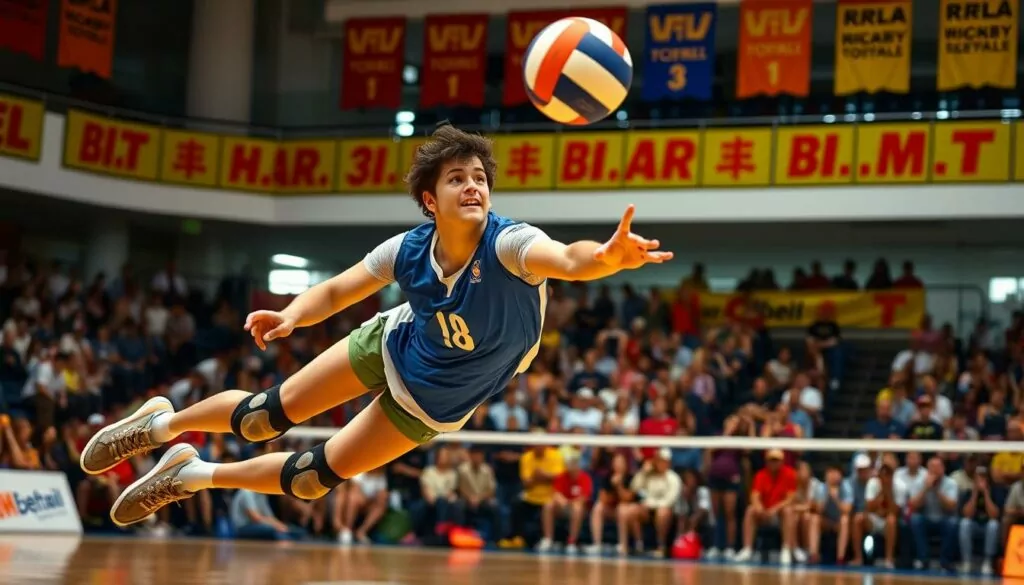
In volleyball, the libero is a key player. They wear a special jersey and focus on defense. Their skills in passing and digging are vital for their team’s success.
Understanding the Libero Role
The libero role was added to volleyball in the early 2000s. They can switch in and out of the game without using up team substitutions. Their main job is to pass and defend well, often taking the place of middle hitters.
Skills That Make a Great Libero
- Exceptional passing and ball control
- Adept defensive skills, including diving and digging
- Exceptional court vision and the ability to read the opposing team’s offense
- Agility and quick reactions to anticipate and respond to the ball
- Strong communication and leadership skills to direct the team’s defensive strategy
Famous Liberos I Admire
There are many legendary liberos in volleyball. They are known for their defensive skills. Here are a few:
- Misty May-Treanor – A three-time Olympic gold medalist, known for her unparalleled passing and defensive prowess.
- Stacy Sykora – A four-time Olympian and world champion, renowned for her relentless hustle and ball-handling skills.
- Kayla Banwarth – A former U.S. National Team libero, recognized for her leadership, communication, and ability to elevate her team’s defense.
The libero position shows how important volleyball defense is. The passing specialist plays a big role in a team’s success. As volleyball evolves, the libero’s role will become even more critical.
The Defensive Specialist Position
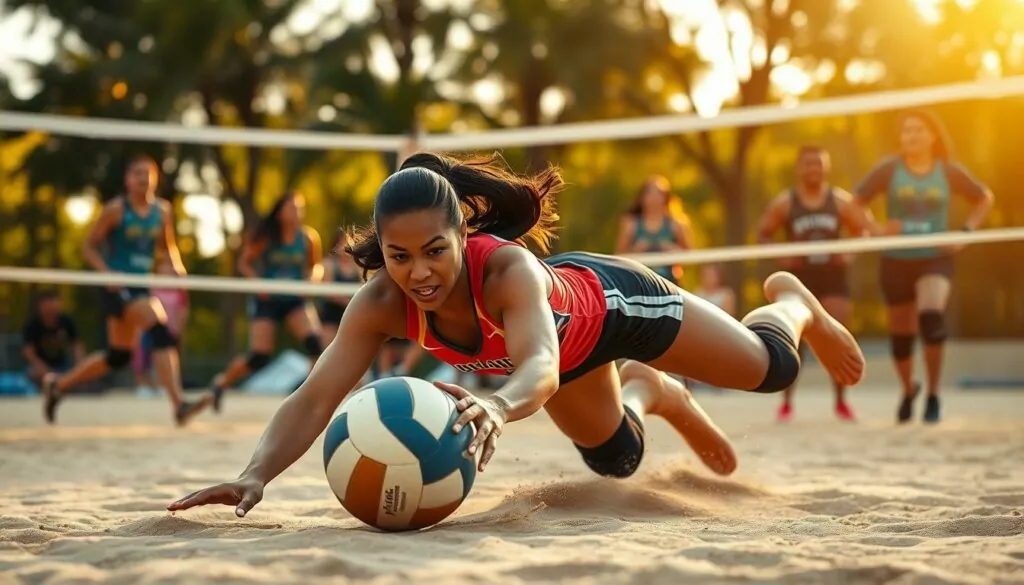
In volleyball, the defensive specialist (DS) is key to the team’s defense. Unlike the libero, the DS is a back-row player who excels in receiving serves and digging. They are the game’s unsung heroes, providing strong defense and consistent serving.
Difference Between Defensive Specialist and Libero
The libero is often seen as the team’s top defender. But the DS’s skills and position are also vital. Liberos wear a different jersey and have special rules. DS players, on the other hand, can be swapped in and out like any other player.
Key Skills Required
- Exceptional ball control and passing ability
- Keen court awareness and reading the opposing team’s offense
- Agility and quick reflexes for diving and digging
- Consistent and accurate serving
Notable Defensive Specialists
Players like Kayla Banwarth, Natalie Hagglund, and Kristen Tupac are highly respected. They have shown their defensive skills, helping their teams with their ball control and back-row dedication.
| Player | Team | Notable Achievements |
|---|---|---|
| Kayla Banwarth | USA National Team | 2016 Olympic Bronze Medalist, NCAA National Champion |
| Natalie Hagglund | USA National Team | 2016 Olympic Gold Medalist, NCAA National Champion |
| Kristen Tupac | University of Washington | 4-time All-American, Pac-12 Defensive Player of the Year |
The defensive specialist position is vital for a volleyball team’s success. They lay the groundwork for defense, allowing the offense to flourish.
Rotational Play and Positioning
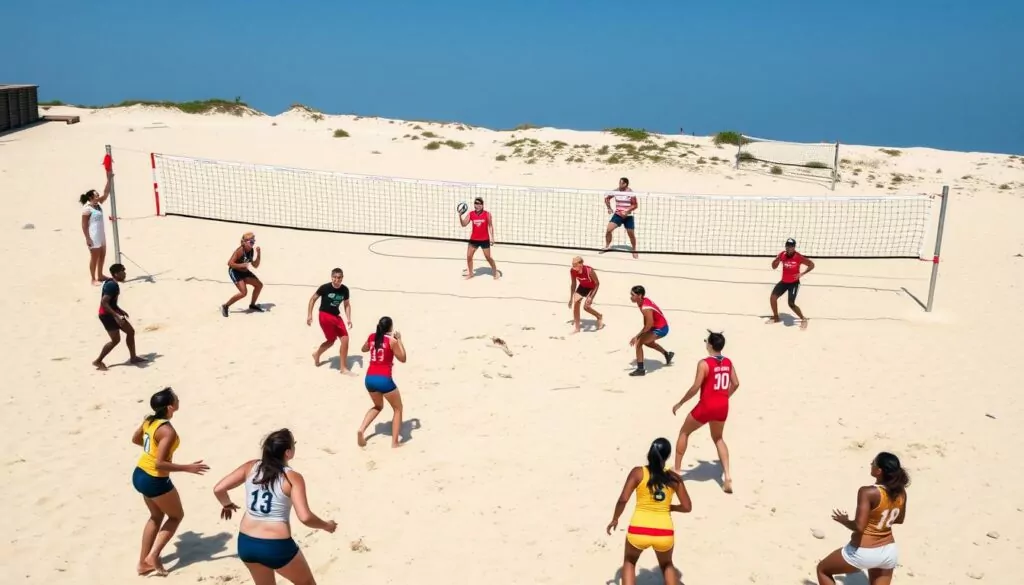
Volleyball rotations are key to the game, giving each player a chance to serve and play both front and back row. This movement is vital for covering the court and following the game’s rules. Teammates must talk clearly during these changes to know their roles and where to stand.
How Rotations Work
After a side-out, the team that receives the ball rotates clockwise. Each player moves one spot to the right. This keeps the serving order and lets everyone play a part in the team’s success.
Importance of Communication
Good communication is essential during volleyball rotations. Players need to know their spots and roles, talking with teammates to move smoothly. This teamwork avoids mistakes that could cost points.
Strategies for Effective Rotations
Coaches use different strategies to improve their team’s rotations. They focus on players’ strengths to cover the court better. Teams practice a lot to master these strategies.
| Volleyball Court Positions | Player Responsibilities |
|---|---|
| Right Back (Position 1) | Serve, play defense, and transition to the front row. |
| Right Front (Position 2) | Attack from the strong side, block, and play defense. |
| Middle Front (Position 3) | Focus on blocking, move for double blocks, and transition to the back row. |
| Left Front (Position 4) | Attack from the weak side, block, and play defense. |
| Left Back (Position 5) | Dig, pass, and transition to the front row. |
| Middle Back (Position 6) | Assist with defense, transition to the front row, and potentially set. |
Teams must understand the value of volleyball rotations, clear communication, and smart positioning. This knowledge helps them cover the court well and succeed in the game.
The Role of Serving Specialists
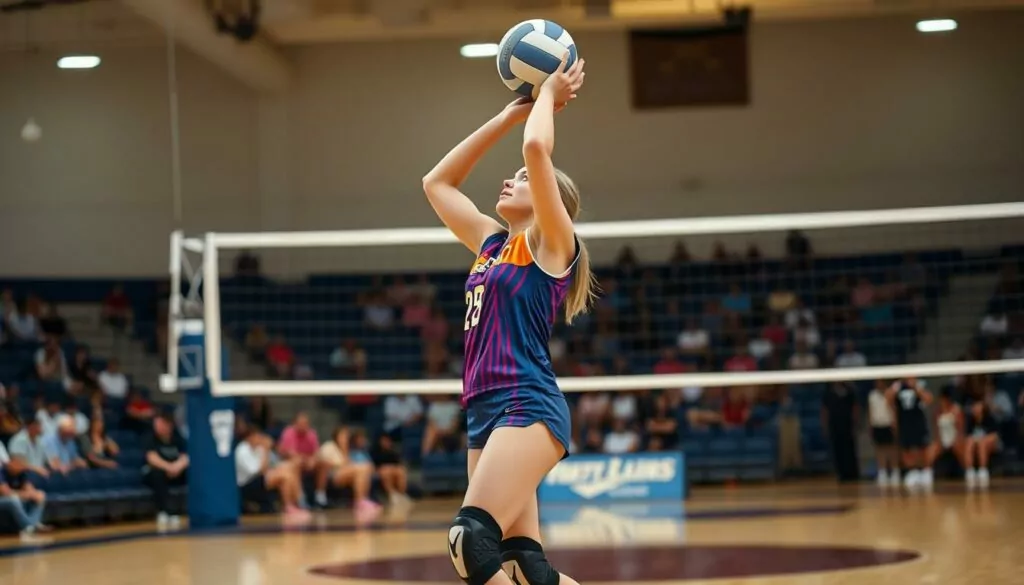
In volleyball, serving specialists are key in changing the game’s flow. They are experts at serving powerful or tricky serves. These can surprise the opposing team and put them on the back foot.
Definition of Serving Specialists
Serving specialists focus mainly on serving. They often ignore other skills to get better at serving. Coaches use them to boost their team’s chances of winning.
Situational Use in Matches
These players are brought in during key moments. Their serves aim to exploit the opposing team’s weaknesses. This can open up scoring chances and change the game’s direction.
Examples of Successful Serving Specialists
- Sergey Tetyukhin, a former Russian volleyball player, was known for his powerful jump serves. They helped his team win many games.
- Destinee Hooker, an American player, used her serving skills to challenge opponents. Her efforts led her team to victory.
- Nimir Abdel-Aziz, an Egyptian player, is famous for his jump serves. They have become a hallmark of his game.
The impact of serving specialists in volleyball is huge. They can change the game with their serves. This makes them essential for any team.
The Impact of Player Positions on Team Dynamics
In volleyball, each player’s role is key to the team’s success. I’ve seen how knowing and using each player’s strengths can make a big difference. It builds a strong team spirit.
Building Team Chemistry
Good team dynamics are the base for winning volleyball strategies. When players understand and respect each other’s roles, they work better together. This creates a team that can handle any game situation well.
Position Diversity and Flexibility
The best teams have players with different skills. But what really matters is being able to change and adapt. Coaches who let players try new positions make their team stronger and more flexible.
Adjusting Strategies Based on Player Strengths
Teams that win adjust their plans to fit their players’ skills. By using each player’s talents, coaches can make the team more effective. This ability to change is what makes a team truly great.
| Player Position | Key Strengths | Importance for Team Dynamics |
|---|---|---|
| Setter | Orchestrating the offense, creating scoring opportunities | Pivotal role in coordinating team plays and maintaining momentum |
| Outside Hitter | Powerful attacks, strategic decision-making | Provides a reliable scoring option and leadership on the court |
| Middle Blocker | Exceptional blocking and quick reactions | Anchors the defensive efforts and disrupts opposing team’s attacks |
| Libero | Exceptional ball control and floor defense | Enhances team’s defensive stability and enables other players to focus on their strengths |
As a volleyball player, I’ve seen how important team dynamics are. The roles of each player are vital for the team’s success. By using each player’s strengths and being adaptable, teams can achieve great things.
Analyzing Different Volleyball Systems
In competitive volleyball, teams use different systems to play their best. The 6-2 and 5-1 formations are two key systems. Knowing how they work can help your team choose the best strategy.
6-2 Formation
The 6-2 formation has two setters on the court. This setup allows for a flexible attack with three hitters in the front row. It keeps the defense guessing with many possible plays.
Having two setters spreads out the setting duties. This can make the team’s setting more accurate and consistent. The three hitters in the front row also create more chances to score, making it hard for the other team to defend.
5-1 Formation
The 5-1 formation uses just one setter. This makes the setter more versatile, as they need to hit and set. It’s a system that values clear leadership and teamwork.
With one setter, the team can have a more unified attack plan. This can lead to better teamwork and decision-making on the court. It’s about finding a balance between setting and hitting.
Choosing the Right System for Your Team
Choosing between the 6-2 and 5-1 formations depends on your team’s strengths. Consider your players’ skills, their playing styles, and how well they work together. These factors are key in picking the right system.
There’s no one system that fits all teams. It’s about understanding your team’s abilities and being open to trying new things. Success comes from constantly improving your strategies.
Training for Specific Positions
Effective volleyball training programs are made for each player’s unique needs. As a coach, I know how key position-specific training is. It helps my athletes shine in their roles and boost the team’s success.
Tailoring Drills for Each Role
Setters work on drills that improve their hand positioning, decision-making, and ball control. Hitters focus on their approach and arm swing. Defensive players and liberos practice passing and digging to get better at controlling the ball.
Physical Conditioning and Skills Development
Physical training changes with each position. Jumpers, like outside and middle hitters, need explosive power to jump higher. Defensive players, including liberos and defensive specialists, do agility drills to move faster and react quicker.
Resources and Tools for Training
Coaches use many resources and tools for training. They have special equipment like setting platforms and hitting harnesses. They also use advanced video analysis software to help players improve their skills and game strategy.
By focusing our training on each player’s position, we help them reach their best. This makes our team balanced and strong on the court. Position-specific training is a big part of our volleyball development program.
Assessing Player Compatibility
Building a great volleyball team is more than just talent. It’s about finding the right mix of players. As a coach, I focus on player compatibility to create a strong team. I match players based on their strengths and weaknesses to make a balanced team.
Team Needs Assessment
First, I do a detailed team needs assessment. I look at the current team, find out what’s strong and weak, and what each position needs. This helps me see where we need to improve, like in passing or blocking.
Position Pairing Strategies
After understanding the team’s needs, I start thinking about how to pair players. For example, a great outside hitter and a skilled setter can be a strong combo. A libero and defensive player can also work well together to stop the other team’s attacks.
Importance of Player Versatility
In today’s volleyball, being versatile is key. Versatile players can play different positions, giving us more options. This helps us adjust our strategy during games. By focusing on player compatibility and team composition, my players can perform their best and help us win.
“The beauty of volleyball is that it’s a team sport, and it takes all six players on the court to be successful.”
| Position | Percentage in Iranian Premier League (2015) |
|---|---|
| Setter | 13% |
| Opposite Hitter | 27.5% |
| Outside Hitter | 15.9% |
| Libero | 15.9% |
| Middle Blocker | 27.5% |
Transitioning Between Positions
Volleyball is a dynamic sport where players may need to switch positions. This can happen for many reasons, like strategic changes or physical growth. These position changes can be both opportunities and challenges for players.
Reasons for Position Changes
There are several reasons why volleyball players might switch positions:
- Team Needs: Coaches might ask players to change roles to improve the team’s performance.
- Physical Development: As players get stronger, they might fit better in different positions.
- Strategic Adjustments: New strategies might require players to take on new roles.
Skills Transfer Between Positions
Fortunately, skill transfer between positions can make the transition easier. For example, a middle blocker’s passing skills can be useful as an outside hitter. A setter’s court vision can also work well as an opposite hitter.
Challenges Faced by Transitioning Players
Despite the benefits of skill transfer, transitioning can be tough. Players must learn new responsibilities and adjust to different views of the court. Effective coaching and targeted training are key to a smooth player adaptation to the new position.
The ability to switch positions is a valuable skill in volleyball. It lets players contribute in different ways and grow their skills. By facing the challenges and opportunities of position changes, athletes can keep improving and loving the sport.
Conclusion: Embracing Your Volleyball Position
Exploring volleyball positions shows finding the right fit is key for growth and team success. Each role requires unique skills, physical traits, and a strategic mindset. It’s important to know your strengths, try different roles, and find where your passion is.
Finding the Right Position for You
Volleyball offers many positions for different players. Whether you’re great at setting, hitting, blocking, or defense, there’s a role for you. Try out different positions in practice to find your natural talents and what you enjoy most. Don’t be scared to try new things – it’s a rewarding journey of self-discovery.
Encouragement for Aspiring Players
To all aspiring volleyball players, embrace your position with dedication and excitement. Every role on the team is vital, and your contribution can make a big difference. Play with a growth mindset, always trying to get better and learn more about volleyball. Remember, the journey is ongoing, and mastering your position will be rewarding.
Continuing Education and Growth in the Sport
Mastering a volleyball position is a lifelong journey that needs ongoing learning and improvement. Look for mentors, attend camps, and study professional players in your position. Use tools like the SkillShark volleyball evaluation app to track your progress and find areas to improve. By dedicating yourself to your craft, you’ll become a better player and help your team grow and succeed.

